Survey Says: Top Marketing Challenges for Associations in 2020 and Beyond
Plenty of challenges face association marketers and communicators in our media-saturated culture, but which ones deserve priority attention and effort? Which challenges will have the most impact in terms of increased membership value or most improved membership recruiting going into 2020?
At the 2019 Digital Summit in Washington, DC, Naylor’s chief marketing officer Dave Bornmann hosted a panel with Charlie Jones, senior vice president for global brand management at the Futures Industry Association (FIA) and Adam J. Smolyar, chief marketing and technology officer of the Urban Land Institute (ULI) that conferred about the importance of collecting and analyzing marketing and membership data in practical, useful ways.

They used the top five challenges that emerged from respondents to Naylor’s 2019 Association Communications Benchmarking Report as a discussion guide about the most important marketing priorities association communicators should address in the twenties, and how FIA and ULI are meeting these same challenges.
Dave: Our first challenge to address is, how do associations cut through information clutter in their industry marketplace? In our latest Association Communications Benchmarking Survey, 70% of respondents cited this as a challenge. In 2018 it was 68%. How do your organizations get members’ attention?
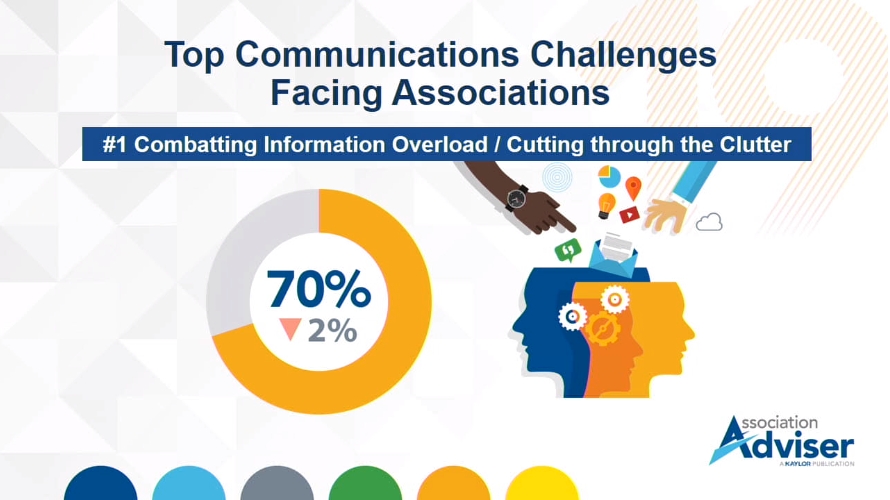

Adam: Who are we kidding? We’re contributing to the clutter. Our average member gets more than one email per day from us! Combat the clutter by sending information that isn’t considered “clutter.” It’s only clutter if it’s not relevant or personalized in some way. We keep a content calendar that we look at each day to see which members are receiving which emails and ensure we’re sending out cohesive, continuous messaging.
We use the data we have to be smarter. If we know someone attended a sustainability event recently, only send them info about upcoming sustainability-related events. It’s about trying to connect with the member based on the information we know about them.

Charlie: We’ve spent the last two years exploring what’s available in terms of personalization applications and technology. Our goal is to create an infrastructure that allows the member to customize the information they receive from FIA. We do this in four ways:
First, members can customize their information preferences in a self-serve model by logging in to our website and opting-in to which types of information they want to receive from us. As part of our onboarding process, we also contact them personally to explain our various communications options to determine what and how they like to receive information from FIA. Staff then records those preferences in our AMS (association management software). We also have invested in an email marketing automation platform that allows members to choose whether or not they want to receive information going forward within each individual communication, by unsubscribing immediately or linking to the self-service portal where they can opt in and out of our various communications.. We want to make it as easy as possible to collect this information in our AMS and apply it going forward.
Second, we are upgrading our CMS to Drupal 8. We surveyed our members about our website’s value and found out they couldn’t locate the info they wanted. A lot of that had to do with our website’s design and how we organized information, but it also had to do with outdated functionality. So, we’re changing all of that, and creating a robust search tool, simplifying our site navigation and showing members different ways to access information.
Third, we’re using a feature-rich marketing automation platform that allows us to create better, more concise and targeted messages. By studying the data we get back from those emails, we can modify how we write and build our messages.
Finally, social. The survey says associations are dialing back on social, and so are we. We focus on LinkedIn and Twitter. With both platforms we try to tie every message back to the FIA website. We offer content on these platforms that encourages people to click to the website where they can do a deeper dive on content they prefer.
Dave: There’s new tech such as artificial intelligence that is helping associations cut through clutter. The American Marketing Association, for example, watches what people open and click on within their newsletters. As time goes on, the AMA can see what type of content engages members, and they’ve been able to increase open rates from the 15-17% range up to 40%. ASAE has also recently introduced AI-powered newsletters. It’s another tool to explore to help ensure you’re delivering relevant content to your audience.
Technology such as AI impacts the way associations communicate in a large way. The No. 2 challenge from the Benchmarking Survey is communicating member benefits effectively. Sixty-seven percent of respondents said this is a challenge for them. Adam, tell us about how you’re facing this challenge.
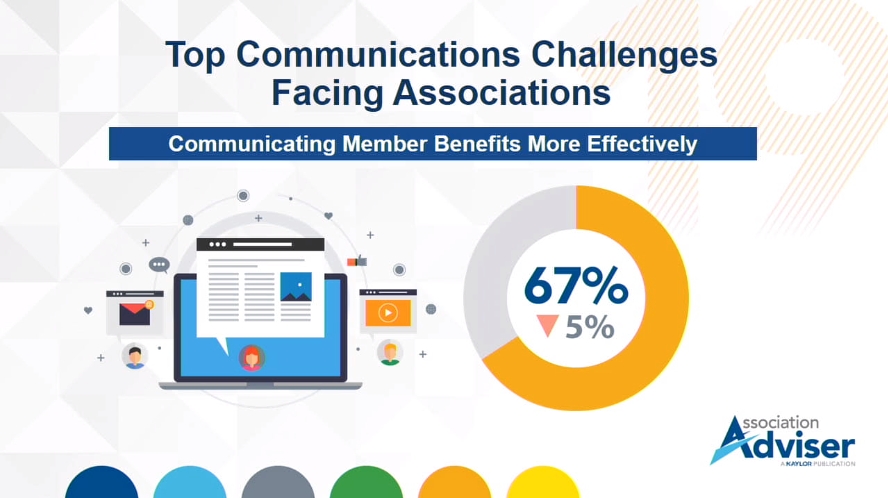
Adam: It’s a real issue. No matter what organization you’re with, members don’t actually know the benefits they receive, and probably think they get benefits that they don’t. How do we make sure we onboard them correctly? That they understand their benefits? We try to engage with our members in many ways. We’ve found through our research that attending three events leads to a 50% greater chance of renewal. This is statistically true across all membership segments. But it’s not actually about attending physical events only; it’s about any engagement. Members could join a panel, serve on a committee; it doesn’t matter. If members do anything with us during the year, they are 50% more likely to renew.
Now with onboarding, we’ve found that making sure they know about their opportunities to engage also makes members more likely to renew. So onboarding feeds our business objectives as well as engagement objectives. We offer a quick survey for members about how they want to be involved, such as through learning or networking. We also provide information about this through email and our website. We started doing second-year onboarding because we’ve found that it takes three years, on average, for members to start acting as a normal population and settle into a membership rhythm. Most of the members we lose drop out within two years. If we can keep them for year three, we typically have them for the long term. So we’ve created a welcome kit for members and a physical mail piece that we think will be very effective compared to 5 to 10 years ago. It will complement our digital communications.
Charlie: We’re also focusing on onboarding, particularly for new members. We reach out and explain what’s available to them in terms of benefits, working groups and committees and how they can be involved. Being a trade organization, we don’t always have the opportunity to reach all the individuals within our member firms. So that initial outreach with the primary contact representing the firm is very important in determining our reach and ultimately the value they receive from membership. We have a six-month follow-up campaign where members receive something every month that elaborates more deeply upon one aspect of their membership benefits, such as how to connect with members near them, education and conferences, our networking opportunities, and so forth.
For existing members, we try to help justify the value of the dues their company is paying by creating “engagement reports.” These are not easy because typically your AMS will capture only 30% of how your members truly engage. It’s mostly transactional. However, engagement is broader than just what we sell them. It’s participation on committees, access to information, networking and their association within your organization. We’re trying to package that along with our annual report and an overview of all member benefits so they can see what they’re NOT taking advantage of. These three pieces will hopefully more than defend the value of membership in FIA and encourage members to renew.
Dave: The next two stats tell us that 63% of association communicators have challenges customizing their communications for different member segments. There’s still a lot of one-size-fits-all communication going on. Second, there’s a challenge of engaging younger professionals. Can you talk about how you segment members?
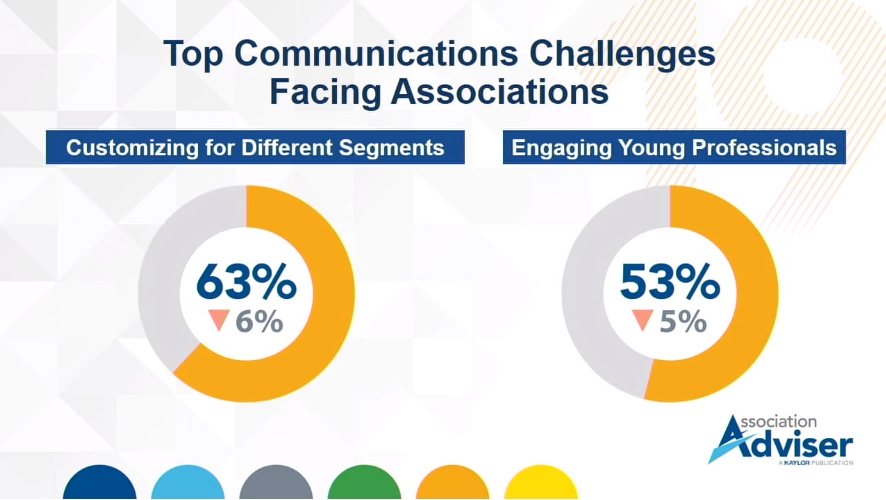
Adam: We collect a LOT of data and have some successes segmenting it. We have an amazing women’s leadership initiative that has done a lot of programming nationally and globally. We have the gender for about 96% of our membership, so we know who these types of activities appeal to and who participates and volunteers in such events.
On the young leadership side, we have a whole other challenge and initiative. The Institute subsidizes membership for young professionals (under 35) by 50% of the cost of dues. But there was a cliff: a steep decline in membership retention once they turned 35. We thought it was because at age 35, your membership price doubles. We tried another way of handling the price increase, but that didn’t matter; we still saw members leave at 35. So we conducted some focus groups to understand why members left. It turns out, members left because once they aged out of the young professionals cohort, they could not participate in the member programming they were previously involved in. They were out of the clique! They didn’t have any familiar programming to attend, so they didn’t see value in staying anymore. Now we have dedicated initiative building for 30-somethings. It was a large a-ha moment for us.
Charlie: Recently, we invested in a new AMS which forced us to rethink the data we were capturing or weren’t capturing. As a global organization, geographic segmentation is critical in addition to job functional area, years in the industry and/or attending our events and other behavioral variables such as logins, networking or social activities and registration patterns. We segment by geography, demographics, and behavioral variables. That helps us identify areas of interest, job function area, and years of attending association events. We’re getting better at market segmentation by applying the data we collect. The best segmentation is data-driven, so we continue to strive to collect useful data and apply logic to it that customizes messages going forward. We’re still a long way from getting there, but we know it’s an ongoing journey.
Dave: The next challenge is doing a better job of understanding member needs. In our survey, 60% of respondents said this is a challenge. It seems like a lot of associations aren’t keeping a pulse on what their members look for in membership. They tend to do programming for a couple years, but then switch to something else. What are your associations doing that is innovative in this area?
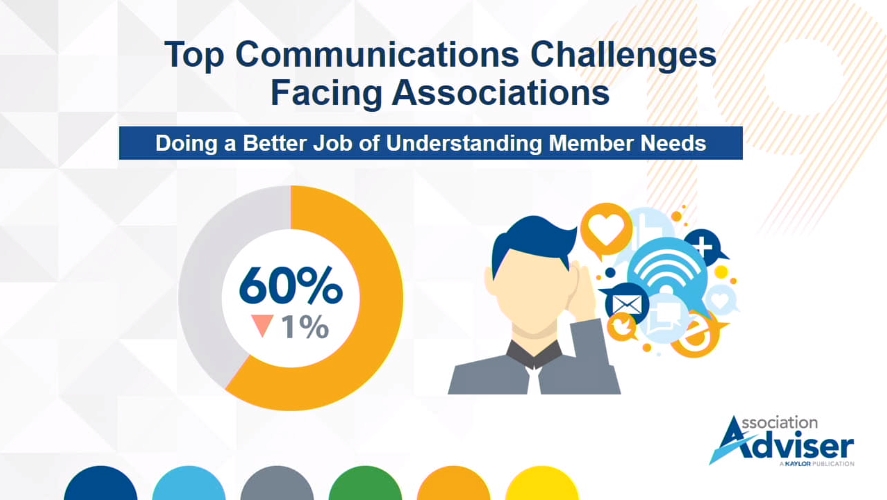
Adam: This connects to the benefits conversation, in that associations should ensure member benefits and how you articulate them actually connects to member needs. We’ve have been trying to listen to members more closely over the past three years through focus groups and surveys to understand what they need. In the past year, we instituted a more disciplined, quarterly membership survey. Every member is surveyed twice over the course of a year. At the end of the year, we compare results to a benchmarking tool. This system gives us the ability to test things. We can test pricing of products or offering, such as the young leadership pricing we want to try.
We strive to really listen to members, not just by asking, but by changing up our messaging and seeing how members respond. We’ve told members, we want you to know you can always reach us. We have an email, [email protected] that we promote all over the website, for members to send questions and feedback. It doesn’t get used often, but that’s not the point. The point is that we are repositioning our brand as one that is member-centric and member-focused.
Charlie: About four years ago we conducted our first comprehensive membership study in almost 10 years. That’s clearly not ‘best practice,’ but the comprehensive effort gave us a strong roadmap of what we needed to invest in to create an infrastructure that would better deliver and respond to the areas we identified as problematic. We also conducted a communications-specific survey. Through that, we identified that our website and other communications needed to be improved. We do ongoing attendee surveys at all our major conferences. Taking all this info and applying it to our actions going forward is what we’re trying to do. You have to build the infrastructure to collect data, but unless you also have a culture that knows how to extract, analyze, and make use of it, collecting data is pointless. So the word ‘listening’ is popular but you must be willing to adjust.
The other thing we’ve done is create a ticketing system for the inquiries that come to our three offices from three continents. This helps us organize in a way that lets us look at emerging patterns that reveal friction points. The ticketing system gives us a quicker, more effective way to respond to member concerns and help us identify the problematic areas we need to fix.
Adam: And if I may add, member surveys are a great way to test whether or not you’re cluttering their inbox. We always ask if we send just enough emails, too many, or too few. Seventy percent of our members tell us we send just enough, 15% said we send too many, and 15% said we send too few, so we know we are in a perfect spot!
Dave: Our last challenge related to collecting and using data more effectively, is that associations have data in their AMS, career centers, community boards, event registration platforms, and so on. How do you get a 360-degree view so you can really understand your membership?
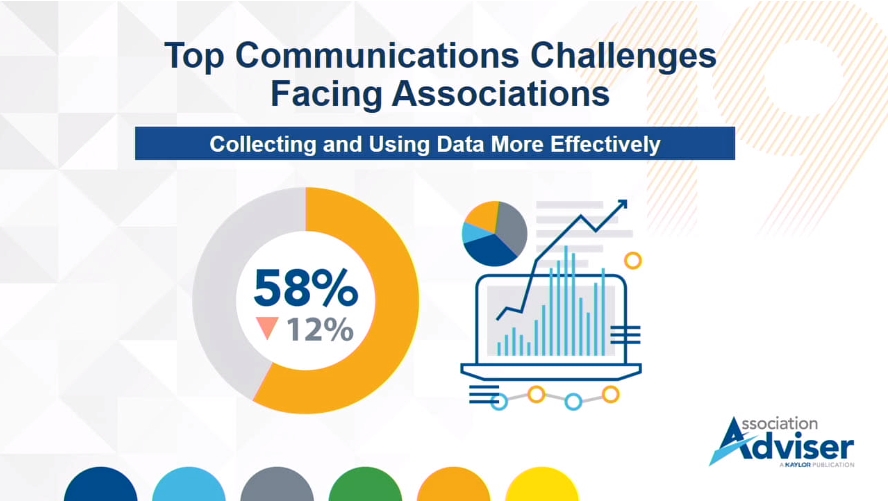
Adam: It’s huge. Collecting is easier. We have deemed our main AMS system as our database of record. We collect all membership data, financial transactions, and engagement actions through it. Our email and LMS platforms are connected to it by API. With the exception of some Google Analytics information, everything goes through our AMS, which presents the data to us in a more cohesive way. What’s still missing, and one of our biggest challenges, is deciding what to do with the data. And in some cases we have too much data. How do you find that nugget that’s useful? If I don’t have an engaged member who is becoming an at-risk member, how can I implement a program that will alert me that another member, 6 months into the year, needs to intervene and have coffee with them?
We’re building a knowledge sharing platform on top of our other platforms. The data itself with the help of AI-powered search engines, will help us generate useful info for members. Imagine a platform that has all of our content already in it – webinars, case studies, books, research. We can see what our members look for and know the top searches and keywords used. That becomes useful info we can share with members to tell them how to better use our platforms.
On the other side, for us as content developers, we will know those keywords that they’re not finding. The platform becomes a live content demand generator that shapes the work we need to do. The data becomes quite strategic. I’m excited about where we’re going to take it.
Charlie: We started on a quest to become a data-driven culture five years ago. That means going beyond membership and marketing departments. Everyone in the organization has a responsibility to collect and use data. Through our new AMS, we’re developing plans for how we’re going to use data to drive our work. It’s not easy, and we have a lot of challenges in front of us with this adoption of a new normal. But we made this investment because we need that infrastructure to effectively collect data and change the attitude of how data gets used in our organization.
Dave: We struggle with that in my organization, too. It’s important not to chase the ‘shiny object’ because there will always be a new shiny object that will collect data for you. So look at the pockets of data that you already have and make sure you’re finding useful insights. There are going to be insights you haven’t yet found. We’re marketers and we always want to take advantage of the next big thing. But we haven’t yet leveraged everything we already have available through MarTech components.
Now for a question from the audience: We have a lot of staff turnover among our institutional members. What do you do if you have a long-standing institutional member that might need a refresher about their benefits?
Adam: We started with our corporate accounts, doing a webinar about our member engagement tools. It walks them through how to get the most out of benefits with ULI. We actually had more members sign up after we started offering this webinar. Our webinars sometimes attract thousands of people, so they are an easy way to reach members and get them to participate in our association.
Your turn: How does your organization manage its data? What are your biggest data management and action challenges? Share your experiences in the comments below.
Download the results and analysis of our first wave of survey respondents here.
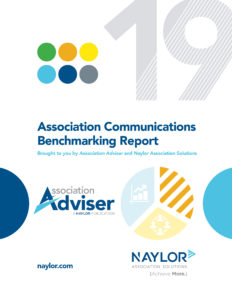 The 2019 Association Communications Benchmarking Survey is open year-round. Click here to create a free account to take the survey at any time. Participants that complete at least 50% of the survey gain access to a personalized Best Practices Report Card that compares your answers to those of other respondents, and grades your communication efforts against others’. You can log back in at any time and modify your survey answers as your organization improves its communication offerings, allowing you to track your progress and see your gains in visual form.
The 2019 Association Communications Benchmarking Survey is open year-round. Click here to create a free account to take the survey at any time. Participants that complete at least 50% of the survey gain access to a personalized Best Practices Report Card that compares your answers to those of other respondents, and grades your communication efforts against others’. You can log back in at any time and modify your survey answers as your organization improves its communication offerings, allowing you to track your progress and see your gains in visual form.

